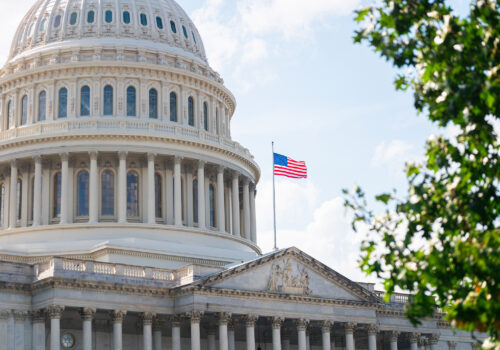Central bank digital currencies versus stablecoins: Divergent EU and US perspectives
The relationship between central bank digital currencies (CBDCs) and stablecoins will take center stage this year. New United States policies support dollar-backed stablecoins and oppose CBDCs. European policies take the opposite stance, arguing that CBDCs—including the digital euro and digital pound—provide financial stability, while cryptocurrencies and stablecoins create financial stability risks. All policymakers agree on one point: both CBDCs and stablecoins will significantly impact the global role of the US dollar.
Few were surprised, therefore, when President Trump began his second term with an executive order that prioritizes stablecoins as the preferred mechanism for safeguarding both the global role of the US dollar and financial stability. The executive order also stated that CBDCs create financial stability threats. In contrast, the monetary policy minutes from the December 2024 European Central Bank rate-setting meeting took the opposite position and proposed that crypto assets could create financial stability threats for the eurozone.
The 2025 reserve currency policy landscape: Four key issues to watch
Legislation: Despite their policy differences, European Union (EU) and US policymakers all face the same hurdle. CBDCs can not be issued without legislation. Lawmakers in Brussels, London, and Washington are each declining to move forward quickly. The European Parliament to date has declined to schedule a vote on the digital euro package submitted by the European Commission—despite urging by the ECB. Nor has the UK Parliament moved forward with a digital pound initiative.
The Republican-led Congress and the White House oppose CBDCs, ensuring that no CBDC legislation will move forward in the United States in the foreseeable future. The Federal Reserve agrees. Chairman Jerome Powell yesterday testified to Congress that he will not propose or pursue a digital dollar during the balance of his tenure at the central bank. Chairman Powell’s term expires in spring 2026. All relevant policymakers in the United States (the White House, Congressional leaders, regulatory agencies, the central bank) are now united in their opposition to a domestic CBDC. Their focus now turns towards articulating a legislative and regulatory framework supporting stablecoins.
House Financial Services Committee Chairman Hill’s 2025 interview with CNBC confirms that leading US lawmakers believe expanded stablecoin adoption would help “extend the reserve currency status” of the US dollar globally. In addition, Federal Reserve Governor Christopher Waller now publicly supports stablecoins “because they are likely to propagate the dollar’s status as a reserve currency, though they need a clear set of rules and regulations.” Senate Banking Committee Chairman Tim Scott weighed in during January, pledging to craft a stablecoin “regulatory framework that…will promote consumer choice, education, and protection and ensure compliance with any appropriate Bank Secrecy Act requirements.” It remains to be seen if dollar-backed stablecoins could strengthen the dollar’s role in the global payment system.
The structure of legislation will materially impact growth trajectories for stablecoin markets domestically and internationally, with implications for US sovereign bond markets. For example, a regulatory framework could require stablecoin issuers to hold US Treasury securities to back their stablecoins, thus guaranteeing liquidity and demand for US dollar-denominated sovereign paper. Additional proposals to create a crypto asset reserve at the federal level could provide additional liquidity support to crypto markets.
Geopolitics: President Trump campaigned on promises to safeguard the global role of the dollar. His promises included wielding tariffs as a mechanism to discipline foreign countries that undermine the global role of the dollar, presumably in addition to aggressive sanctions enforcement. The Trump administration is not alone in raising red flags regarding certain CBDC use cases. Growing concern exists internationally that non-US dollar CBDC networks could be used to evade Western sanctions. Against this backdrop, in October 2024, the Bank for International Settlements withdrew from the wholesale CBDC mBridge project, whose members include central banks from China, Hong Kong, Thailand, the United Arab Emirates, and Saudi Arabia. The BIS General Manager reiterated the policy that “…the BIS does not operate with any countries, nor can its products be used by any countries that are subject to sanctions…we need to be observant of sanctions and whatever products we put together should not be a conduit to violate sanctions.” In addition, Russia has called for a multipolar global financial system with a separate non-dollar clearing and settlement system.
Distributed free markets: Stablecoins currently occupy a tiny fraction of financial market activity. Crypto itself remains minor relative to US capital markets. Globally, the estimated stablecoin market size is $227 billion in market capitalization, as compared to $6.22 trillion for US capital markets and $3.39 trillion for global cryptocurrency markets. If current double-digit growth rates for stablecoins continue, they could constitute a considerable proportion of overall crypto market capitalization, if not capital markets themselves. More importantly, the vast majority of stablecoins are pegged to the US dollar.
Rapid adoption rates paired with speedy transaction volumes and velocity in stablecoin markets mean that today’s stablecoin and CBDC decisions may amplify ongoing shifts in reserve currency markets. Dramatic shifts in reserve currency status historically have been rare events. The more likely scenario for threats to dollar dominance involve a range of alternative currencies nibbling at the dollar’s role at the margins. While the US dollar is comfortably in the lead, accounting for 49.2 percent of international payment messaging through SWIFT, its share of global FX reserves has fallen from 71 percent in 2001 to 54.8 percent at present. Decreased demand for dollars has increased demand for non-traditional currencies, gold, and several pairs of local currencies, rather than traditional reserve currencies.
In this context, choices made by individual users can materially impact global reserve currency status. The broad adoption of US dollar-backed stablecoins could even reverse the de-dollarization trend. Decisions made by policymakers during 2025 will thus materially impact how the stablecoin and dollar markets evolve.
European crypto rules: EU officials promote the digital euro as a mechanism for delivering strategic and economic autonomy relative to the US dollar. At the retail level, they compete with local payments processes currently dominated by US credit card companies. Globally, they facilitate increased usage of the euro as an international transaction currency. Secondary use cases include using blockchain technology to create “ tokenized” (euro-denominated) deposits that would cement the role of commercial banks within the payment system. European policymakers have also begun experimenting with tokenized securities. Slovenia became the first eurozone sovereign country to issue a tokenized euro area sovereign bond. In December, the Bank of France became the first eurozone central bank to complete transactions in the secondary market for both sovereign fixed income and equity using an unnamed digital currency on a blockchain.
However, if a critical mass of individuals in a country holds wealth in a foreign currency stablecoin, the competitive landscape, if not the survival of other reserve currencies, requires that they provide a digital alternative. The scenario also creates incentives for other jurisdictions to make it difficult to achieve interoperability with non-euro stablecoins, while creating economic hurdles for local users to choose US dollar-backed stablecoins—essentially preserving their economic and monetary sovereignty.
Some see the newly issued EU crypto regulatory framework—the Markets in Crypto Assets (MiCA); and specifically the 1:1 ratio of required liquid reserves for stablecoins —as a strategic tool to raise barriers to non-EU issuers of US dollar-denominated stablecoins. MiCA extends bank-like regulatory requirements to crypto asset issuers and intermediaries. We discussed that framework and its relationship to the US crypto asset policy landscape in our January 28, 2025 Econographics essay. The framework potentially provides European regulators with the time and tools to play defense by regulating local stablecoin markets to permit either a digital euro or euro-denominated stablecoins to gain market traction. Market data will provide the metric for policy effectiveness.
Barbara Matthews is a nonresident senior fellow at the Atlantic Council’s Geoeconomics Center. She is also Founder and CEO of BCMstrategy, inc., a company that generates AI training data and signals regarding public policy.
Hung Tran is a nonresident senior fellow at the Atlantic Council’s Geoeconomics Center and senior fellow at the Policy Center for the New South; a former senior official at the Institute of International Finance and International Monetary Fund.

At the intersection of economics, finance, and foreign policy, the GeoEconomics Center is a translation hub with the goal of helping shape a better global economic future.
Further reading
Tue, Jan 28, 2025
The 2025 crypto policy landscape: Looming EU and US divergences?
Econographics By Hung Tran, Barbara C. Matthews
High level regulatory and policy alignment is possible. Divergences, heated rhetoric, and drama are inevitable.
Thu, Nov 16, 2023
CBDCs will further fragment the global economy—and could threaten the dollar
Econographics By Hung Tran, Barbara C. Matthews
Divergent regulatory and technological standards are evolving along geopolitical fault lines. Such an outcome would be costly.
Thu, Jan 23, 2025
What is next for crypto regulation in the US?
Econographics By Ananya Kumar
What does success on the regulatory front actually look like? What does it mean for the rest of the world? We dive into the dozen bills under consideration in Congress and zoom in on the three big themes for crypto regulation in 2025.


